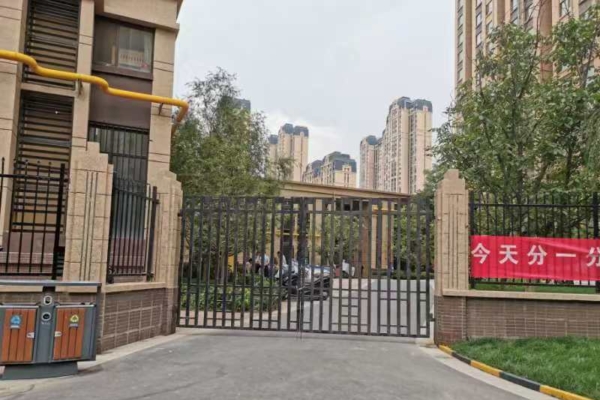The Chinese Communist Party has long implemented a dual-track housing system, with one track raising the prices of commercial housing while the other focuses on providing low-cost subsidized housing. In a residential area in Lanzhou, Gansu Province, residents who are associated with authorities not only enjoy public rental housing but also occupy facilities in the neighboring commercial housing courtyards, leading to longstanding complaints from property owners.
According to relevant documents issued by the Chinese Communist Party, public rental housing is mainly intended for urban families with medium to lower incomes facing housing difficulties, with “strict control of single unit floor area below 60 square meters.” Rental housing with an area not exceeding 70 square meters primarily targets small unit sizes and offers rents lower than market rates in the same area.
Ms. He from Gansu shared with a reporter from Dajiyuan that in mainland China, public rental housing is supposed to be allocated to low-income groups, yet in reality, those who can secure these units may not necessarily be homeless individuals but rather people with connections or those who have paid for such connections. Those truly in need of housing have limited chances of obtaining these units.
The Zhonghai Heshanjun community in Lanzhou, Gansu, covering 40,000 square meters with 30 high-rise buildings, 3000 units, and tens of thousands of residents, is divided into East and West sections. In the northwest corner of the East section, two public rental housing buildings were constructed separately from the commercial housing courtyards during the 2017 handover. However, residents reported that officials occupying public rental housing had combined multiple units into one.
Moreover, residents of public rental housing demanded access to the green spaces and facilities of the commercial housing area, expressing dissatisfaction with the size of their own courtyards. This led to a confrontation between public rental housing and commercial housing residents, resulting in police involvement and subsequent arrests of three commercial housing owners on charges of assaulting officers.
In July 2019, a special meeting was convened by Zhonghai Property Management to address the issue, involving various departments including the Lanzhou Housing and Urban-Rural Development Bureau and the Lanzhou Housing Reform Commission.
The meeting outlined requirements for residential developments with a total area exceeding 40,000 square meters to allocate 5%-8% of the total area for subsidized housing under government ownership. Following the principle of “equal rights for rental and sale,” residents of public rental housing were meant to have equal access to basic public services as commercial housing owners.
Subsequently, the district urban management bureau issued a notice demanding that the property management rectify the fenced-off enclosure.
On July 23, 2019, a day that left commercial housing owners devastated, Mr. Ren, a pseudonym, recalled, “Hundreds of urban management vehicles, as well as special police vehicles, arrived at Angqing Guang City. The queue at the entrance of the community stretched for 500 meters. I witnessed this personally.”
Local authorities mobilized resources including urban management, police, and even the district hospital, to forcefully demolish the barriers between the East commercial housing and public rental housing. Property owners lamented the degradation of services despite paying premium property management fees.
During the pandemic, the community was sealed off with welding, leading to hardships for commercial housing owners who resorted to buying groceries through the sealed gates. In contrast, public rental housing courtyards almost remained unrestricted, causing disparity in movement restrictions. In May 2022, Ms. He’s father fell seriously ill, and she faced quarantine upon returning, leading to lost wages.
Since the beginning of the pandemic, property owners applied to establish an owners’ committee, facing hindrances until the property management committee was finally formed in June 2024. However, the committee held only one meeting without addressing concerns, according to Mr. Ren.
Property owners expressed their desire for the community to be restored to its original state and for accountability in the forced demolition.
Legal scholar Lai Jianping, in an interview with Dajiyuan, highlighted that public rental housing and commercial housing should generally remain separate based on the initial construction plans. Altering this setup to share facilities, courtyards, and green spaces from commercial housing is unreasonable and can impact the quality and sales of commercial properties.
Lai noted that urban management typically lacks the authority to conduct direct demolition operations within communities. In cases of disputes involving property owners, legal recourse through courts should precede administrative enforcement. Property owners have the right to challenge administrative decisions and seek legal redress if necessary.
The prevalence of privileged access to subsidized housing favoring individuals with connections, rather than those in true need, is a common issue in China. This practice, aimed at enriching housing departments, contributes to a culture of corruption and privilege within the system.
Lai emphasized that the Chinese Communist Party’s special privilege system prioritizes officials’ access to benefits and resources, abusing power for personal gain. This pervasive misuse of authority extends from housing allocations to other realms, promoting an environment of favoritism and unequal treatment.
As the story unfolds, the struggle for fair housing access and accountability continues, shedding light on the complex dynamics within China’s public housing system and the challenges faced by ordinary citizens navigating a system marred by corruption and inequality.

